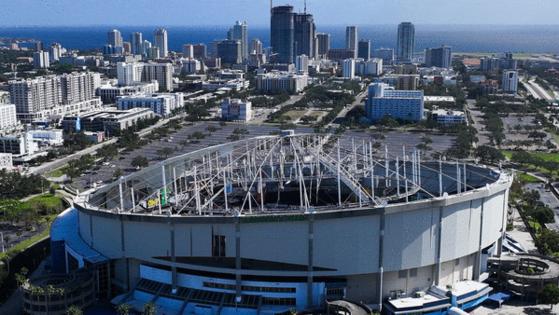John Romano: St. Petersburg is betting millions that Tropicana Field can be salvaged
Published in Baseball
ST. PETERSBURG, Fla. — The City Council reluctantly agreed Thursday to stopgap measures that will protect Tropicana Field from further water damage, even though the stadium’s ultimate fate will not be decided for at least another week.
The council approved up to $6 million in mitigation efforts that will create a temporary drainage system and waterproof the facility’s electrical system, offices, concessions and other exposed areas. The process is expected to take as much as eight weeks.
Should the stadium be declared unsalvageable in the coming days, the city can halt the waterproofing efforts and avoid spending a portion of the $6 million.
While council members expressed concern about approving funds without having a complete picture of the stadium’s viability or the potential repair costs, city staff said it was the least risky option in terms of collecting insurance and avoiding further destruction. Should additional rains cause damage, it’s conceivable the insurance carriers would dispute the city’s claims.
“We have filed an insurance claim for Tropicana Field’s damages,” said Blaise Mazzola, the city’s risk management expert. “As a policy holder, as the insured, it is critical that we mitigate our losses. ...
“Our policy has duties ... and one of them reads ‘take reasonable steps to protect any covered property from future damages.’ By doing the work outlined, we are ensuring that we are able to protect the structure from future damage. If you don’t do this, it could potentially be very problematic for the claim. We could have issues with coverage.”
While the Rays have been curiously silent on their plans three weeks after Hurricane Milton blew the roof off Tropicana Field, it appears clear that the city is holding out hope the stadium can be repaired.
“I would not be here before you today asking to do this if I had any indication, at this moment, that there were serious, significant structural problems at the stadium,” said city administrator Rob Gerdes. “Now, it’s a fluid situation. Something could change, but we’re here because we believe that that’s most likely.”
The city’s position is understandable. With three years remaining on the Trop’s use agreement, St. Pete is responsible for providing the Rays a major league-quality facility. Should Tropicana be unusable the city would be in breach of the use agreement, and the team theoretically could seek damages for revenues lost and costs incurred in moving to a smaller stadium.
After more than an hour of discussion at Thursday’s council meeting, it seems obvious the city is going to be on the hook one way or another.
Back in March, the city opted to reduce its insurance coverage on Tropicana Field from $100 million to $25 million to save $275,000 in premium payments. The decision was made because modeling predicted that the damages from a major storm would not likely exceed $33 to $39 million. With a $22 million deductible, the $25 million policy was thought to be adequate because that would account for $47 million in repairs.
Based on Thursday’s discussions between council members and city staff, it now appears damages will exceed that $47 million threshold. The city is hopeful that FEMA would come up with any funds beyond the city’s deductible and the insurance payment.
“I’m very concerned about any issue occurring with the insurance company because I think insurance is important for our application to FEMA, for this to be an eligible project, possibly, for FEMA repairs,” Gerdes said. “FEMA has notified us it’s an eligible project. That doesn’t mean we’ll be reimbursed. FEMA will not tell you that in advance.”
Council members were not just concerned about the $6 million for the initial mitigation efforts, but also the $22 million deductible and possible costs on top of that. Particularly for a stadium that is slated for destruction in three years to make way for a new $1.3 billion ballpark that the Rays, the city and Pinellas County are teaming up to build as part of a massive redevelopment project on the Trop land.
“One thing I (worry about) is sunken costs,” said council member Richie Floyd. “We get to a point where we’ve spent $6 million and $12 million is (still required) and we spend the $12 million and then there’s $8 million more and now we’ve spent $25 million on a structure that’s going to be torn down soon. So it’s not just, can we save it? It’s also like, is it worth doing all of this?”
The $6 million for waterproofing request was approved by a 6-2 vote with Floyd and Lisset Hanewicz voting against it. Virtually every council member, however, expressed reservations about committing that much money even before actual repairs begin.
“I had the opportunity to tour the Trop and see the damage myself and it’s pretty shocking,” said council member Brandi Gabbard. “It’s very eye-opening. (Team president) Brian Auld and myself were walking through and saying you feel like you’re almost in a post-apocalyptic kind of movie scene when you’re in there. It’s kind of eerie in a way.
“And that’s really, I think, just kind of the beginning of my concern because I do have to ask myself ... is this building that is only going to be used for another three years, worth the amount of investment that we are looking at making.”
Eventually, council members came around to the idea that not safeguarding the stadium today could end up costing the city even more money in the long run.
“I don’t want to risk the insurance proceeds with the city,” council member Ed Montanari said. “I agree with Administrator Gerdes that this is a risk calculation. I’m risk averse. I want to do the safe thing.”
©2024 Tampa Bay Times. Visit tampabay.com. Distributed by Tribune Content Agency, LLC.







Comments